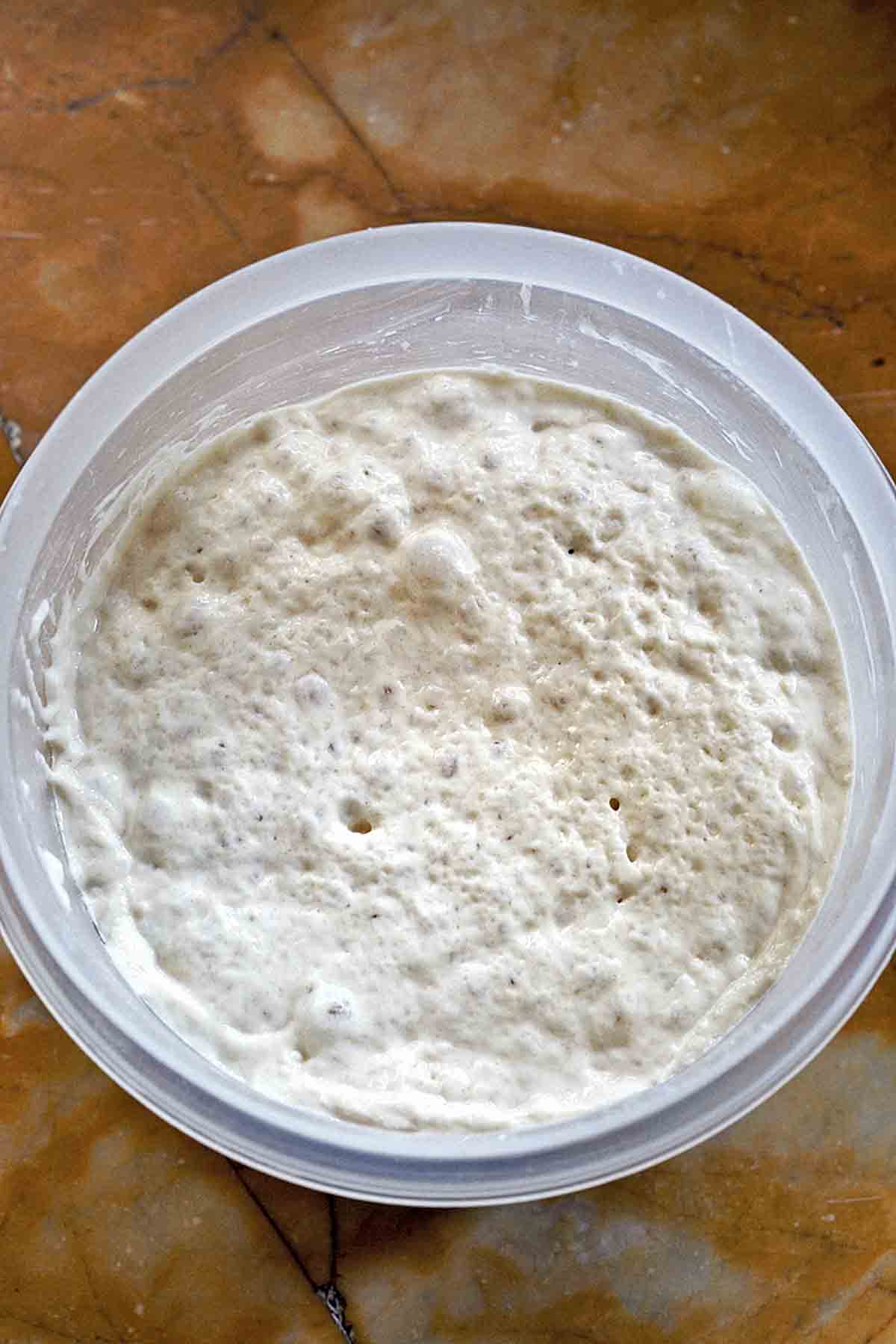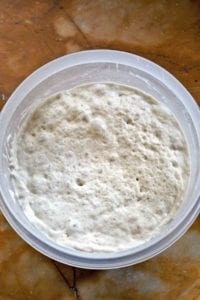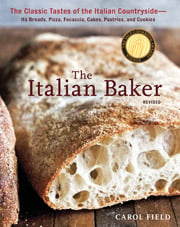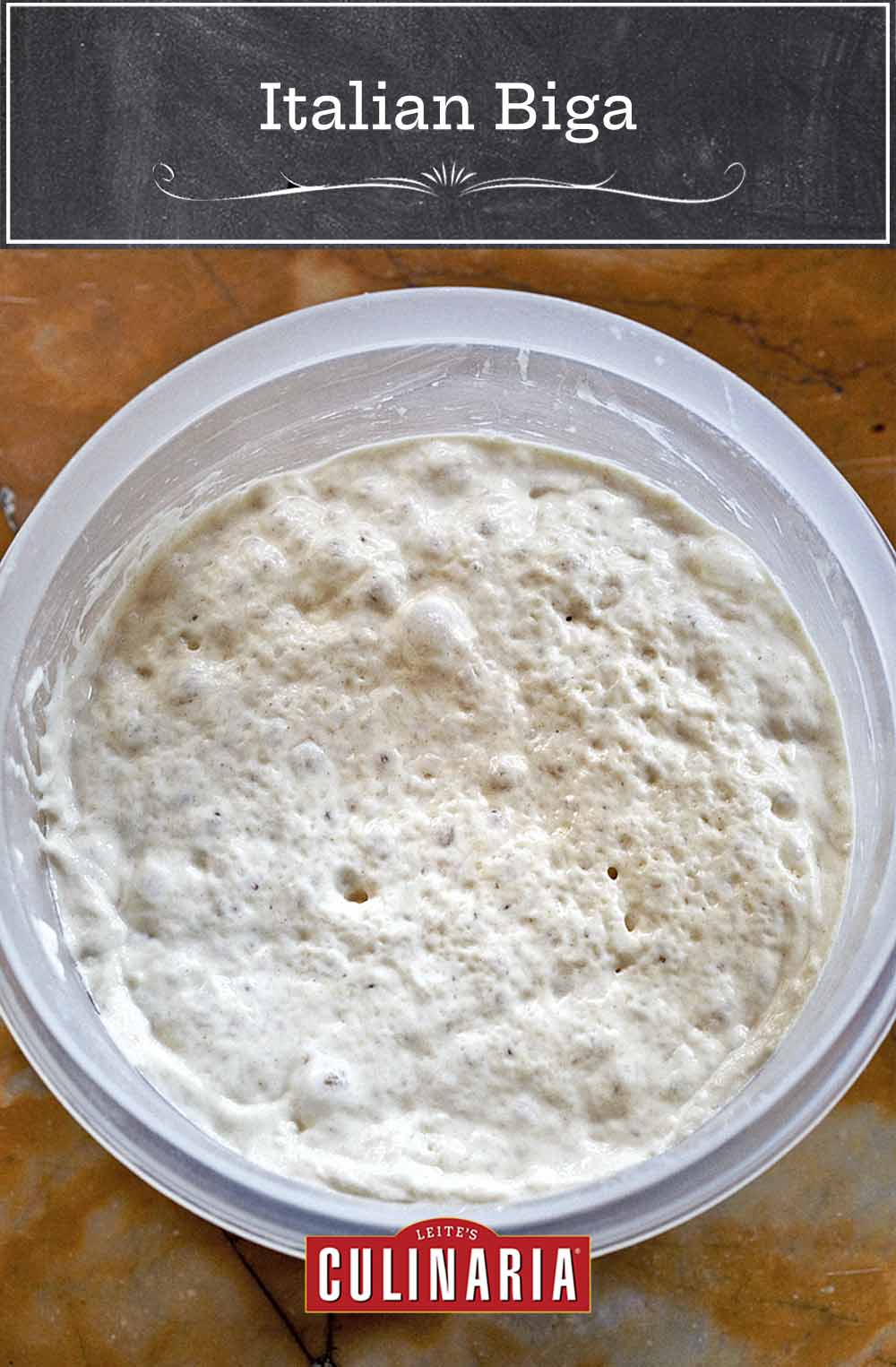
Many of the recipes for classic regional breads, such as this ciabatta recipe, begin with a starter dough made from small amounts of flour, water, and yeast allowed an initial fermentation. The starter, known as biga in Italy, or bighino when in small amounts, not only gives strength to what in Italy are weak flours, it also produces a secondary fermentation from which come the wonderful aroma, natural flavor, and special porosity of the final loaves and wheels of bread.
The important point about a biga is that the breads made with it develop a wonderful taste because their risings are long and bring out the flavor of the grain. Another benefit is that the loaves remain fresher and taste sweeter than those made with large amounts of commercial yeast.
In Italy, bakers use dough from the previous day’s baking to start a new dough. I keep some starter on hand at all times; by having it around, I can decide to make pane pugliese or ciabatta in the morning and have it for dinner that night. Because the first biga must come from somewhere, though, you may make it following the instructions below. It’s remarkable. It freezes very well and needs only about 3 hours at room temperature until it is bubbly and active again, or it can be refrigerated for up to 5 days.–Carol Field
LC Obliged to Biga Note
Behind each and every memorable bite of proper Italian bread we’ve daintily nibbled, hungrily inhaled, or otherwise somehow consumed, we have a biga to thank. So we’re feeling much obliged to Carol Field for this recipe. Nonna not included.

Italian Biga
Ingredients
- 1/4 teaspoon active dry yeast
- 1/4 cup warm water
- 3/4 cup plus 4 teaspoons water, preferably bottled spring water, at room temperature
- 2 1/3 cups unbleached all-purpose flour
- Vegetable oil, for the bowl
Instructions
- Stir the yeast into the 1/4 cup warm water and let stand until creamy, about 10 minutes.
- Stir the spring water into the creamy yeast mixture, and then stir in the flour, 1 cup at a time. If mixing by hand, stir with a wooden spoon for 3 to 4 minutes. If mixing with a stand mixer, beat with the paddle at the lowest speed for 2 minutes. If mixing with a food processor, mix just until a sticky dough forms.
- Transfer the biga to a lightly oiled bowl, cover with plastic wrap, and let rise at cool room temperature for 6 to 24 hours, until the starter is triple its original volume but is still wet and sticky. (The bakers I admire most advise 10 to 11 hours for the first rise, but others are very happy with the 24 hours it takes for dough to truly become yesterday’s dough, and if you like sour bread, allow your biga to rest for 24 to 48 hours or even 72 hours.)
- Cover and refrigerate or freeze the biga until ready to use. (If refrigerating the biga, use within 5 days. If freezing the biga, let it rest at room temperature for about 3 hours until it is bubbly and active again.) When needed, scoop out the desired amount of biga for your recipe and proceed. I strongly recommend weighing the biga rather than measuring it by volume since it expands at room temperature. If measuring by volume, measure chilled biga; if measuring by weight, the biga may be chilled or at room temperature.

Nutrition
Nutrition information is automatically calculated, so should only be used as an approximation.
Recipe Testers’ Reviews
This is a perfectly suitable starting point for most any bread which uses a starter. I bake bread several times a week and it’s nice to have this handy. Sometimes I add this to a bread dough which doesn’t call for a starter just for the added flavor.












Hello! Is it ok if I made my biga when my kitchen was super warm and it rose a ton but it has now fallen? Do I need to start over and use it prior to it collapsing?
It should be ok, Steve. Just chill it until you’re ready to use it.
May I ask a silly question? I understand the biga usage and why, and that there is no salt added to it. And some people take 3 to 5 oz of their dough from their bake and use that old dough for the next bake, which would have salt in it.
So, what, if any, differences might be experienced by using a biga, old dough or a fresh-made old dough as in pate fermentee/preferment? They both or all three would give a great taste, so I do not know why my mind gets boggled in this confusion. Any clarity would be appreciated greatly. Thank you.
Please as simple as one is able as I’m not a professional % baker. I included a pic of my ciabatta bread I have made in the past in my home kitchen. It took me months to learn how to handle the wet dough. Glad I took the time. I look forward to trying this recipe soon.
Great question, Karen. Not silly at all. I’m not a professional baker, either, but I’ll offer you all I know and if we’ve got any expert readers out there, we’d love to hear from you. All of the preferments add flavor to the dough, as well as strengthen the structure, and change the acidity, ultimately helping with quality. The difference may come down to a flavor preference, and each of the pre-ferments requires a different amount of time to ripen, so that may be a determining factor in which one you use. I hope that helps!
Thank you, Angie. I appreciate your taking the time to try and help me with this. It just seems to me that a biga, and a pate fermentee are or can be used one or the other in any French or Italian recipe, just remember to keep the salt addition in the Pate Fermentee in mind. Long rests are very beneficial for wonderful flavor and strength. IDK why I struggle with this. Maybe my mind is overthinking it.
Thank you again Angie.
You’re welcome, Karen. It’s definitely something interesting to think about.
Karen, pâte fermentée and biga are the same thing, basically. Think of fermentée and French biga and biga as Italian fermentée. The only difference is the salt, as you say. I don’t think you have to worry too much about the amount of salt in a fermentée, as it’s minimal.
That being said, most pro bakers say they’re not interchangeable. They have different compositions and textures that’ll affect the final loaf. It’s best to use pâte fermentée in recipes that call for it, likewise with biga.
I hope this helps a bit.
Hi, how long can biga be stored in the freezer? Thank you.
If it’s well wrapped and stored in an airtight container or resealable bag, it should keep for up to 3 months in the freezer, Pam.
Thank you for the reply.
You’re welcome, Pam.